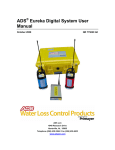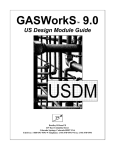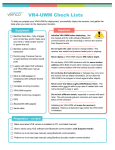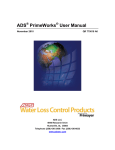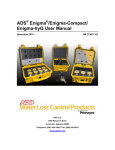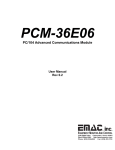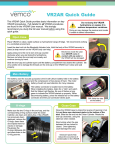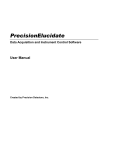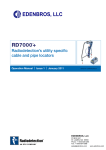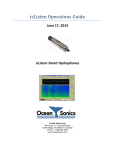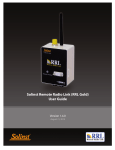Download Eureka2R User Manual - ADS Environmental Services
Transcript
ADS® Eureka2R Leak Noise Correlator User Manual October 2010 QR 775019 A1 ADS LLC 4940 Research Drive Huntsville, AL 35805 Telephone (256) 430-3366 / Fax (256) 430-6633 www.adsenv.com ADS Eureka2R Leak Noise Correlator User Manual Copyright © 2010 ADS® LLC. All rights reserved. ADS® is a registered trademark of ADS LLC. Microsoft®, Windows®, and Windows Vista® are registered trademarks of Microsoft Corporation. All other brand and product names are trademarks or registered trademarks of their respective holders. Notice of Proprietary Information The information contained herein represents the latest information available at the time of publication. ADS reserves the right to make any changes or modifications to the content of this document, without notice, to reflect the latest changes to the equipment. No part of this document may be reproduced in any form without the written consent of ADS. ii ADS Eureka2R Leak Noise Correlator User Manual Table of Contents Chapter 1 Introduction ...................................................................... 1 ADS No-Hassle Warranty and Return Policy ..............................................2 New Product Warranty...........................................................................2 Replacement or Loaner Equipment........................................................2 Shipping .................................................................................................2 Product Returns ......................................................................................3 Chapter 2 Principles of Leak Noise Correlation .............................. 5 Methods for Locating Leaks ........................................................................6 Sensor Positioning Errors ............................................................................8 Leak Beyond the Sensors .......................................................................8 Leak on the Connecting Pipe .................................................................8 Trunk Mains and Plastic Pipes ...................................................................10 Chapter 3 The Eureka2R System .................................................... 11 Optional Equipment ...................................................................................12 Sensors .......................................................................................................13 Attaching Accelerometers to Pipes ......................................................13 Installing Hydrophones ........................................................................14 Using a Ground Microphone................................................................15 Radio Transmitters .....................................................................................16 Interpreting the LED Indicators When Recharging .............................17 Choosing a Location for a Transmitter ................................................18 Chapter 4 Eureka2R Operation ....................................................... 19 Connections................................................................................................20 Positioning the Correlator Antenna .....................................................20 Turning On the Unit .............................................................................21 Resetting the Correlator .......................................................................21 Main Menu .................................................................................................22 Configure .............................................................................................23 Correlate ...............................................................................................24 Listen....................................................................................................29 Fast Track.............................................................................................30 Recharging the Eureka .........................................................................31 Battery Charger ..........................................................................................32 External Battery Charger (supplied prior to July 2010) ......................32 Internal Battery Charger (supplied after July 2010) ............................32 Safety Information ...............................................................................33 iii ADS Eureka2R Leak Noise Correlator User Manual Chapter 5 Appendix ......................................................................... 35 Specifications .......................................................................................35 Basic System Components ...................................................................36 Optional Equipment .............................................................................36 Velocity and Filter Look-Up Tables ....................................................37 iv ADS Eureka2R Leak Noise Correlator User Manual CHAPTER 1 Introduction Since the initial development of leak noise correlators in the mid 1970s, these instruments have demonstrated unsurpassed performance in effectively locating leaks in pipe networks. Leak location using a correlator provides a degree of precision unavailable through any other method, particularly in environments exhibiting high noise levels. As a result, correlators are now standard tools in leakage control. Early correlators were bulky, difficult to use, and, therefore, had to be mounted on vehicles. Modern technology, accompanied by the ongoing development of microprocessors, has resolved these issues. The current equipment is now truly portable and much easier to use. The ADS® Eureka2R correlator represents a new generation of these instruments, providing new levels of miniaturization, sensitivity, accuracy, and ease-of-use for pipe network applications. The Eureka2R provides enhanced durability and operational speed. The 3.3-pound (1.5-kg) instrument can be carried in one hand, and the entire kit fits in a rugged carrying case for transportation. The integrated, rapid-charging battery (typically charging 75% in 1 hour) minimizes service time. The Eureka2R uses DSP (Digital Signal Processor) technology, a RISC (Reduced Instruction Set Computer) processor, and notch filters to optimize ultra-low frequency processing. Since these frequencies travel furthest in pressurized pipes, Eureka2R has a specialized correlation mode for optimum performance on large diameter and plastic pipes. This instrument can print paper reports on-site or store data for future display, analysis, or output. Under normal operating conditions, the Eureka2R can store several weeks of data. 1 ADS Eureka2R Leak Noise Correlator User Manual ADS No-Hassle Warranty and Return Policy The following sections detail the hassle-free warranty and return policy for the ADS Eureka2R Leak Noise Correlator. New Product Warranty ADS will repair or replace any Eureka2R equipment (supplied by ADS) that is defective in materials and/or workmanship for up to two (2) years following the date of shipment from ADS. To make a warranty claim, the customer should simply call ADS at (256) 430-3366 or contact the ADS Support Center toll-free at (877) 237-9585. The ADS Client Services Agent will assign a Return Materials Authorization (RMA) to the customer’s claim immediately. The customer shall return a defective unit or part to ADS for troubleshooting and repair or replacement within 10 days with the RMA. Replacement or Loaner Equipment For a defective part, ADS will ship a replacement part immediately once the customer makes an initial claim. However, if ADS does not receive the defective part within 30 days or testing concludes that the part experienced excessive wear and tear or abuse for the period of use, ADS will bill the customer for the replacement part. For a defective unit, at the customer’s request, ADS will ship a temporary (loaner) unit to the customer at the time of the initial claim. However, if ADS does not receive the temporary unit from the customer within 15 days of receiving the repaired or replacement unit or testing concludes that the unit experienced excessive wear and tear or abuse for the period of use, ADS will bill the customer for the temporary unit. Shipping The customer must pay to ship defective equipment to ADS for repair or replacement. However, ADS will incur the costs for shipping the repaired or replacement equipment back to the customer using the same priority shipment procured by the customer upon returning the defective equipment to ADS. 2 ADS Eureka2R Leak Noise Correlator User Manual Product Returns If the customer is not satisfied with the performance of the Eureka2R, the customer may return the equipment within 30 days for a full refund, provided the condition of the equipment is in the same condition as sold, except for expected or normal wear and tear for the period of use. 3 ADS Eureka2R Leak Noise Correlator User Manual 4 ADS Eureka2R Leak Noise Correlator User Manual CHAPTER 2 Principles of Leak Noise Correlation Leak noise correlation is used to detect leaks in pipes with a positive internal pressure, where leaks allow a loss of flow to the outside. The movement of fluid through the leak causes rapid pressure changes around the site of the leak, establishing a noise source at the leak. This noise travels in both directions, at the same velocity, along the pipe from the leak. These principles are used to determine the leak location. Note: Noise is not a constant frequency, like a musical note, but a random and constantly changing blend of different frequencies. The correlator operates on this principle. 5 ADS Eureka2R Leak Noise Correlator User Manual Methods for Locating Leaks Previous methods of leak location relied on an initial detection of a noise, which was then traced along ground level to identify the location of the maximum noise. The assumption was that this location was directly above the location of the leak. The equipment used for this method included listening sticks and stethoscopes, but these were difficult to use if the noise proved too faint or loud for accurate location. Background noise was another problem; therefore, electronically-filtered amplifiers were introduced in an attempt to overcome such problems. A correlator operates by comparing the noise detected at two different points in the pipeline. Noise travels from the leak in both directions along the pipeline at a constant velocity (depending on several factors). Therefore, if the leak occurs at an equidistant location between the two sensors, these sensors will detect the noise at the same time. Conversely, if the leak does not occur at an equidistant location, then the sensors will detect the same noise at different times. This correlator measures this difference (delay) in time. The following diagram provides an illustration of this principle: D Valve A L L Leak V*t Valve B X Assume the sensors are located on valves A and B (convenient access points for underground pipes). However, the leak occurs closer to valve A. By the time a particular noise from the leak has reached A, the same noise heading towards B has travelled only as far as X. The distance from X to B causes a delay (t) before the noise arrives at B. Therefore, the correlator detects the delay (t) between the arrival of the noise at A and B. Assume the velocity of sound is V and the distance between the sensors is D. As the distance from X to B = V * t (velocity x time), then D = (2 * L) + (V * t). This equation may be rearranged to provide L, the distance from the sensor closer to the leak site: L= D − (V * t ) 2 The sound velocity can be calculated based on the pipe diameter and material, and the distance between the sensors can be determined by careful measurement. Therefore, the correlator can calculate and display the location 6 ADS Eureka2R Leak Noise Correlator User Manual of the leak as a direct distance from the closer sensor. The correlator also may be used to measure the actual velocity of sound in the pipe under investigation, ensuring the greatest accuracy in locating the leak. Note: This discussion assumes the correlator is connected directly to both sensors. Since this is often impractical, the connections typically are made using radio links with negligible delays. However, the principle remains the same. 7 ADS Eureka2R Leak Noise Correlator User Manual Sensor Positioning Errors Correlator operation relies on the location of the leak existing between the two sensors. However, two contexts can prevent this from occurring. Leak Beyond the Sensors If the leak is located beyond the length of pipe between the sensors, the correlator will ignore the transit time from the leak to the nearest sensor because the transit time will be the same for both sensors. This will give the impression that the leak exists directly at the location of the sensor closest to the leak (occasionally referred to as out-of-bracket). Therefore, one sensor must be moved to locate the leak position accurately. Leak on the Connecting Pipe If the leak is occurring on a pipe that connects to the pipe being measured, the noise will appear to spread from the connection point and, therefore, indicate that point as the location of the leak. This requires moving one sensor to the connecting pipe, ensuring the leak falls between the sensors, to accurately locate the leak. A thorough knowledge of the entire pipe network layout is essential to ensure the correlator is taking measurements on the correct section of pipe and that no possibility exists for leaks on branch pipes, causing false readings. 8 ADS Eureka2R Leak Noise Correlator User Manual 9 ADS Eureka2R Leak Noise Correlator User Manual Trunk Mains and Plastic Pipes It can be extremely difficult to obtain a satisfactory correlation when examining trunk mains or long lengths of plastic pipe. The nature of these pipe networks causes predominately low frequency leak noise because high frequencies attenuate rapidly. The Vector Correlate function of the Eureka2R (described in Vector Correlate on page 27) is a technological development that significantly improves correlation under these conditions. Vector correlation can deliver results even when all other correlation methods fail. 10 ADS Eureka2R Leak Noise Correlator User Manual CHAPTER 3 The Eureka2R System The basic Eureka2R system consists of the following components: Eureka2R correlator Two accelerometers Radio transmitter (red) Headphones Operating manual (this publication) This basic system has only one radio link and, therefore, requires connecting the correlator unit directly to one sensor. The headphones may be connected to either the correlator or the radio transmitter and, therefore, permit listening to leaks at either location. The battery charger is designed to recharge the correlator and the radio transmitter(s) quickly and simultaneously, either from a 110V / 220V mains supply or from a vehicle’s 12Vdc supply. 11 ADS Eureka2R Leak Noise Correlator User Manual Optional Equipment In addition to the basic system, other equipment also is available that enhances the versatility of the Eureka2R system. A second radio transmitter (blue) may be used to locate the correlator unit anywhere, regardless of the position of the sensors. ADS recommends using this option when operator safety is a concern. A set of vehicle-mounted antennas extend the range over which radio signals may be satisfactorily received and allow use of the correlator from inside a vehicle, if desired. These antennas have magnetic mounts for ease of use. Other sensors available include a set of hydrophones with various adapters to suit different hydrants. Sensor extension cables also are available for locations with deep access chambers. A Correlator Reference Unit is an optional testing device available to ensure proper operation of the Eureka2R system. 12 ADS Eureka2R Leak Noise Correlator User Manual Sensors The sensors detect the leak noise and convert it to an electrical signal. Two types of sensors are available: an accelerometer and a hydrophone. Accelerometers, which mount magnetically to the external surface of the pipe, detect noise transmitted through the wall of the pipe. Hydrophones, which mount inside the pipe for direct contact with the water, are more sensitive than accelerometers and are preferable for investigations involving low leak noise level conditions (such as distant leak sites), plastic piping, or large diameter pipes. Hydrants provide useful access for this purpose. Attaching Accelerometers to Pipes The accelerometers supplied with Eureka2R have an integrated magnet for easy attachment to ferrous pipes. For non-ferrous pipes, clamp the accelerometer to ensure contact between the base of the sensor and the pipe. Another option involves attaching a set of mechanical grips to the nonmagnetic valve stem and then attaching the sensor with its magnetic base to the grip. Note: The accelerometer requires a good acoustic coupling to the pipe; therefore, mount it to as smooth a surface as possible. Accelerometer attached to valve body Make sure the cable does not pull on the accelerometer because this can affect the effectiveness of the acoustic coupling. ADS recommends placing any spare cable into the chamber to minimize the possible effects of wind noise. Assess the site conditions to determine whether to connect the accelerometer directly to Eureka2R or to the radio transmitter. 13 ADS Eureka2R Leak Noise Correlator User Manual Installing Hydrophones Connecting a hydrophone to a hydrant requires a hydrant cap suitable for the local hydrant and an adaptor that accommodates the 1-inch male BSP threaded connection on the hydrophone and the female threaded port on the selected hydrant cap. Note: ADS recommends removing the hydrant cap and allowing the hydrant to flow to clear out debris and stagnant water in the pipe prior to attaching the hydrophone hydrant cap assembly and re-pressurizing the hydrant for the survey. In addition, verify that the hydrant exhibits adequate water pressure. Mount the hydrophone to the hydrant in the following way: 1. Assemble the hydrophone and hydrant cap using the transitional thread adaptor and tighten to ensure a good seal under pressure. Consider using sealing washers or thread seal tape (also known as PTFE or plumber’s tape) on the threading to prevent leakage. 2. Verify that the hydrant valve is closed. 3. Install the hydrophone assembly onto the hydrant, and then tighten it in place. 4. Make sure the bleed valve is closed and the assembly is secure. 5. Slowly open the hydrant valve, and verify that no leakage occurs from the hydrophone. If leakage occurs, close the valve, remove the assembly, and apply measures (such as seals or taping) to the assembly threading to address the leakage before proceeding. 6. If no leakage exists, fully open the hydrant valve to completely charge (e.g., fill) the hydrant. Filling the hydrant applies pressure to the caps, including the hydrophone assembly, on the hydrant. 7. Open the hydrophone bleed valve slightly to allow air to escape. 8. Close the bleed valve once only water is escaping. Once installed correctly, connect the hydrophone directly into the Eureka2R or to the radio transmitter. Before removing a hydrophone assembly, make sure the hydrant valve is closed. Then, reopen the bleed valve to release the pressure. 14 ADS Eureka2R Leak Noise Correlator User Manual Using a Ground Microphone One of the accelerometer sensors may be used as a simple surface listening device. It normally is used for verifying the location of a leak by detecting a peak in noise at ground surface along the pipeline and in the area determined through the Eureka2R correlation. To use this feature, first connect the cable to the socket on the right side of the correlator and turn it on. Then, connect the headphones, and select Listen Mode. This procedure is described in Listen on page 29. Processing the signal delays the display of the noise level; therefore, make sure the noise has settled to a steady level before recording. 15 ADS Eureka2R Leak Noise Correlator User Manual Radio Transmitters Radio transmitters Radio transmitters couple the signals from sensors to the Eureka2R correlator. One transmitter (red) is always used; the other transmitter (blue) may be replaced by a direct cable connection (to the Eureka2R correlator), where appropriate. The transmitter is a sealed unit powered by rechargeable batteries. To prepare the transmitter for use, connect the aerial (antenna) on the top of the unit and then connect the sensor cable (hydrophone or accelerometer) to the top port, under the rubber protective cover. Connecting the sensor turns on the transmitter. Radio transmitter LED indicators (top five indicators are level indicators; middle two indicators are status indicators; object on bottom is the pushbutton) WARNING: Do not leave the transmitter turned on (with a sensor connected) without the antenna connected. This will cause the transmitter to overheat. The leak noise signal strength displays on the LED level indicators. If the top (red) LED is illuminated, the signal is too strong and is saturating the radio. (The red LED typically flashes intermittently at peak noise levels.) If the 16 ADS Eureka2R Leak Noise Correlator User Manual signal is too strong, loosen the contact between the accelerometer and the pipe. To monitor the leak noise, connect the headphones to the lower port. Select the LOW radio output level by pressing the button (the default setting when turned on is HIGH). An illuminated LED status indicator identifies the selection. Select the appropriate setting based on the following conditions: HIGH (high-power output) Select this option when the transmitter is more than 66 feet (20 m) from the correlator or a clear line-of-sight to the correlator is not available. LOW (low-power output) Select this option when the transmitter is less than 66 feet (20 m) from the correlator and in the line-of-sight. Using this setting also extends the length of time required between charging. ADS does not recommend operating transmitters less than 33 feet (10 m) from the correlator. This may cause excessive cross-channel interference. Make sure the antennas are connected to the correlator and to the antenna port on the transmitter. Pressing the button shows the status of the transmitter battery. The number of indicator LEDs illuminated represents the remaining charge. If the lowest LED is flashing, less than a 30-minute charge remains in the battery. To charge the transmitter battery, connect the charger cable to the sensor port on the transmitter and turn on the charger. A transmitter may be charged independently, with the other transmitter, or with the correlator unit. Use only the Eureka2R battery charger supplied by ADS. For more details on using the Eureka2R battery charger, refer to Battery Charger on page 32. Interpreting the LED Indicators When Recharging The five numbered yellow LEDs indicate the amount of charge left in the battery. The progress of the recharge displays on the two (red and green) status LEDs. A flashing red LED means the transmitter is connected to the mains charger, but is awaiting recharge. A steady red LED means the transmitter is recharging at the fast rate. A flashing green LED means the transmitter is recharging at the slow rate. The transition from fast charge normally occurs at 80% of full charge, but can occur sooner if the battery becomes excessively warm. Green and red LEDs flashing together indicate that the fast charge is limited by a very low temperature. The recharge will finish at the slow rate. 17 ADS Eureka2R Leak Noise Correlator User Manual A steady green LED means the transmitter is fully recharged. When other indicator LEDs are flashing, a battery fault is occurring. The most likely cause would be an overheated battery. Recharging the transmitter in full sunlight is one way that a battery can become overheated. When this occurs, disconnect the transmitter and allow it to cool. If the fault indication persists after the transmitter is cool, return the unit to ADS for service. Choosing a Location for a Transmitter Locate the transmitter aboveground. Whenever possible, obtain a clear lineof-sight to the correlator. Do not conceal the transmitter by placing it close to parked vehicles, metal fencing, or other metallic objects. 18 ADS Eureka2R Leak Noise Correlator User Manual CHAPTER 4 Eureka2R Operation Important Note: When turning on a Eureka2R, it takes 3 to 4 seconds for the red ON light to illuminate and an additional 6 to 7 seconds for the display to activate. This occurs because the Eureka2R performs a boot sequence similar to a computer. Please do not press the ON button repeatedly! 19 ADS Eureka2R Leak Noise Correlator User Manual Connections Based on the application, a Eureka2R may be operated in one of the following ways: Using two radio transmitters Using one radio transmitter and a direct connection to an accelerometer or hydrophone Using a direct connection to a single accelerometer sensor Make all direct connections to the same port, located next to the printer port on the right side of the instrument. This port also serves as the connection port for the battery charger and the communication interface between the Eureka2R correlator and a PC. When applicable, connect headphones to the port on the bottom edge of the instrument. Eureka2R correlator Positioning the Correlator Antenna When in use, rotate the antenna from the stowed position below the instrument to a vertical position on the left side. If the antenna is difficult to rotate, loosen the retaining ring. However, effective radio signal reception can often occur with the antenna in the storage position (i.e., folded beneath the housing of the correlator). ADS recommends using the antenna in this position unless radio reception is poor. Occasionally, when using the correlator (with an extended antenna) very close to one radio transmitter while a very weak signal is coming from the other transmitter, a center correlation (i.e., Td = 0.00 feet per second) may display. Prevent this condition by moving the Eureka2R away from the closer transmitter. 20 ADS Eureka2R Leak Noise Correlator User Manual Vehicle-mounted antennas may be used to increase the range of the system. To connect this kind of an antenna, remove the fitted antenna located above the connecting elbow (i.e., unscrew the black sleeve). Turning On the Unit Turn on the unit by momentarily pressing the button at the top right-hand side of the keyboard. Press the button again to turn off the unit. Note: Do not repeatedly press the ON button; Eureka2R performs a boot sequence similar to a computer. It takes 3 to 4 seconds for the red ON light to appear and an additional 6 to 7 seconds for the display to illuminate. When the Eureka2R screen appears, press any key to advance to the main menu. To conserve the battery charge, the correlator automatically turns off if no key has been pressed after 15 minutes. A warning beep will sound for the last 2 minutes of this timing cycle. Resetting the Correlator In the unlikely event the correlator locks up, reset it by holding down the ON button until the screen clears. This may take up to 20 seconds. The correlator is then ready for use and may be turned on again in the usual manner. 21 ADS Eureka2R Leak Noise Correlator User Manual Main Menu The main menu provides three functions and displays the status of the battery. Since ambient lighting is unpredictable, the main menu allows immediate adjustment of the screen contrast. Turn on the backlight when necessary. Note: Using the backlight reduces the operational time per battery charge in half. The Exit key is at the button of all function screens. Pressing this key displays the main menu. The Back key is at bottom of all sub-functions. Pressing this key displays the previous screen. Pressing the ? key at any time displays a Help screen. The Help screen displays data relevant to the function currently in use. Pressing the Exit key restores normal operation. Eureka2R introduction screen 22 ADS Eureka2R Leak Noise Correlator User Manual Configure The Configure screen allows you to set the correlator default conditions. Configure screen Change Language allows you to change the text to the selected language. Change Date enables you to set the correct date. Set the month and year using the Next Month, Previous Month, Next Year, and Previous Year buttons; set the date using the left and right arrow keys. Confirm the selection using the Enter key (↵). Change Time enables you to set the correct time using the Next Hour, Previous Hour, Next Minute, and Previous Minute buttons. As with the date selection, confirm this selection using the Enter key (↵). Change Units allows you to enter either metric or imperial measurements in the correlation modes. Fast Track (on/off) determines whether the Eureka2R operates in Advanced mode (making all features available) or in Fast Track mode (allowing for very rapid leak location). 23 ADS Eureka2R Leak Noise Correlator User Manual Correlate Correlate screen The correlation (Correlate) screen main window displays the following, from top to bottom: Total length under investigation Leak noise correlation along the length Pipe sections in proportion, with (where possible) the material and length of each section Cursor Radio transmitter(s), with signal strength indication Cursor position from each sensor Status window showing the operating conditions Mode of operation Adjust the cursor position using the left and right arrow keys. Use the Go to Peak button to move the cursor directly to the point of best correlation. The radio transmitter symbol flashes when no signal is available. When operational, the number of waves displayed with the symbol represents the signal strength. When one connection is made directly to an accelerometer or hydrophone, a cable symbol displays in place of the blue radio symbol and no signal strength displays for that channel. The lower window displays the time and date, the elapsed time since correlation began, and the battery status. 24 ADS Eureka2R Leak Noise Correlator User Manual Pipe Details The Pipe Details button allows you to select the pipe material, diameter, and length; you may select up to six different pipes for a survey length. Enter the length of the selected section using the alphanumeric keys, and then press the Enter button. Select the pipe material from a list. Change the selection from material to material or scroll through the combinations of material and diameter. Be sure to select the correct diameter range and material. Press the Enter key (↵) to confirm the selection. If the pipe length contains sections of different materials or diameters, the arrow keys allow you to include or subtract a later section of pipe at the Red or Blue ends. You may define up to six separate sections. The pipe length displays with the sections shown proportionally. All sections display as the same length until all lengths have been entered. An arrow connects a data box to a section of pipe. The left and right arrow keys move the arrow from one section to another. Enter the material and length for each section, as described above. The correlator preserves the pipe details until it is turned off. The default pipe details are restored once the unit is turned on again. However, the default values can be modified through the Eureka2R PC software. To restore the default pipe values, select Mode > Survey. Pipe details Mode This function allows the correlator to be used for various tasks. 25 ADS Eureka2R Leak Noise Correlator User Manual Survey This mode provides a quick overview of the leak noise and automatically restores the pipe details to the default conditions. This is ideal for applications where a leak is suspected because it allows for the identification of any peaks in the noise spectrum while, for example, the sensors are reading successive lengths of pipe. Leak Locate Leak Locate is the standard mode of operation through which you can change the pipe details as required and use functions, such as Go to Peak, on the main Correlate screen. Measure Velocity Measure Velocity allows you to measure the actual velocity of sound in the pipe(s). However, there must be a leak in the pipe line at a known position, commonly produced by opening a hydrant. Two main options are available for the leak position: Out of Brackets or Towards Red/ Towards Blue. Out of Brackets means the intentional leak exists at one of the sensor positions or beyond the length bracketed by the sensors, at either end. Towards Red or Towards Blue means the leak is reasonably close to the Red or Blue sensor, within the bracketed length. To ensure accuracy, the distance from the sensor should be less than one third of the total pipe length. This technique involves entering the pipe material and length measured with the usual method, selecting Mode > Measure Velocity, and then selecting from Out of Brackets/Towards Red/Towards Blue. When selecting Towards Red/Towards Blue, enter the distance from the intentional leak to the sensor. Perform correlation in the usual manner, using zoom if necessary to locate the exact peak. Note that an over-range area always exists beyond the ends of the pipe. This is to cover conditions where the nominal velocity is significantly inaccurate, but the correlation in this area is valid. After calculating the velocity value, hit the Leak Locate button. At the prompt, choose whether to use the velocity value instead of the default by selecting one of the two soft keys labeled Yes and No. Then, turning off the manufactured leak allows for location of the unknown leak with improved accuracy. Note: Measuring velocity using this method does not account for more than one pipe material because it can only measure the average velocity over the given pipe length. 26 ADS Eureka2R Leak Noise Correlator User Manual Manual Velocity allows you to enter a value for velocity. This value replaces the velocity obtained from tables. After entering this value through Mode > Measure Velocity, it displays on the main Correlate screen. Once a value has been entered, the button changes to Auto Velocity. Pressing this button uses the default value from the tables. WARNING: Velocity can vary with MDPE (medium density polyethylene) pipes. Values listed in this table are theoretical and, therefore, may cause errors in a practical situation. ADS strongly recommends measuring actual velocity on site wherever possible. Save This function stores the result of a correlation, recalls a previously saved result, and prints the displayed correlation. The screen displays the correlation and identification details. Details This allows you to change the identification text. The three fields include Identity, Site, and Operator. Save This stores the correlation in memory. Print This prints the displayed correlation to the printer. Normal printer error messages, such as Out of Paper, display when necessary. Files This opens a screen for selecting stored correlations. A list of stored results displays. Scroll through the list using the up and down arrow buttons. Delete or recall a selected file using the other buttons. Since recalling deletes the data previously displayed, a warning will display. Vector Correlate This is an advanced signal processing technique that improves correlation on very low frequency signals, particularly in trunk mains and long plastic pipes. However, use this option ONLY when normal correlations fail. It is specifically designed for use with hydrophone sensors. The filters must be set to the 3Hz – 100Hz band. Adjust The Adjust function allows you to set the screen contrast, turn on and off the backlight, adjust the headphone volume and balance, and select the leak noise filters. 27 ADS Eureka2R Leak Noise Correlator User Manual To set contrast, volume, or balance, first select the function and then use the left and right arrow keys to adjust the level. The backlight key serves as a toggle switch, alternately turning on and off the backlight. Select Adjust Filters to improve the correlation when, for example, no correlation exists or the peak is too broad. Two filters are available for separately suppressing low and high frequencies. The High Cycle and Low Cycle buttons cause the selection of the high and low cut-off points. To ensure a pass-band always exists, do not set the filters to overlap. These settings may be applied to accelerometer inputs or to hydrophone inputs by selecting the source with the Accelerometers/Hydrophones button. Filters may be selected automatically using the Use Defaults button, which selects filters for both accelerometer and hydrophone inputs. View The View option allows for a detailed inspection of the leak noise correlation. Control the cursor using the left and right arrow keys. Stop/Restart This button halts and restarts leak noise data processing. Clear This button erases all existing information and initiates a new correlation. Zoom In This button expands the display, with the cursor position serving as the central location. The scale bar below the cursor indicates the degree of zoom by adjusting the length as the zoom varies. The Zoom Out button reverses the zoom process. Noise suppression zones in operation 28 ADS Eureka2R Leak Noise Correlator User Manual Noise Suppress This button allows you to mark one or more sections of the correlation so that these areas will not be used for the correlation calculations. Suppress Start marks the position of the cursor. Moving the cursor, using the left and right arrow keys, causes a suppression zone to appear symmetrically about the Suppress Start point (the cursor moves with the edge of the zone). Selecting the Suppress Stop button records the width of the suppression zone. Selecting the Suppress Clear button deletes the suppression zone indicated by the cursor; selecting the Clear All button removes all suppression zones. Because the vertical scaling of the display occurs automatically, suppressing a section with a high correlation peak will expand the remainder of the display. Listen The Listen mode enables you to store the noise levels detected by a sensor and display them on the Eureka2R screen. Place the accelerometer in a position near a suspected leak and record the noise level. Then, move it a known distance along the line of the pipe and record the noise at that position. Repeat this process to obtain a profile of the noise levels at known (and equal) intervals over a distance. The current noise level displays as the dark section of a vertical bar at the left side of the screen. Pressing the Next button stores the noise level (in the dark section only) to the right of the vertical bar. Stored noise levels are numbered consecutively. Note: Since processing the signal causes a delay before the noise level displays, do not record the noise level until it has stabilized. Clear Clears the display to prepare for the next set of measurements. Adjust Allows you to change the screen, headphone, and noise measurement settings. The Correlate – Adjust section provides a description of these settings. Mute Silences the microphone, allowing the movement of equipment without excess noise in the headphones. To restore sound, press the button again. 29 ADS Eureka2R Leak Noise Correlator User Manual Listen mode operation Fast Track This option is designed for an operator with a recurring work schedule or applications where pipe materials remain unchanged throughout many correlations. Access Fast Track through the Configure function on the start-up screen. Selecting Fast Track will expedite the menu process, requiring less key strokes. When selecting Correlate, the correlation screen will display with a direct menu to Pipe Details, Adjust, Clear, and Go To Peak. Entering pipe details is easy (as described in a previous section). Therefore, inserting the relevant data and achieving a leak location result requires only a minimal amount of time. 30 ADS Eureka2R Leak Noise Correlator User Manual Fast Track correlation screen If the pipe material remains constant, you only need to change the various pipe lengths between each correlation run. Fast Track does not include a function for saving files to memory. This can occur only by setting the correlation to the advanced mode before commencing correlation. Recharging the Eureka Connecting the correlator to the charger illuminates the ON button. If the charger is not ready (i.e., it is charging another piece of equipment), the button will flash continuously; if the charger is ready, the screen display will appear and the button will extinguish. For a fully discharged battery, it may take some time for the display to appear. The screen displays the battery charge similar to a fuel gauge. Therefore, the amount of the charge is always visible. The battery icon displays a 1 when the correlator is on fast charge, 2 when the correlator is receiving a top-up charge, and 3 when the charge is complete. When fully discharged, the correlator requires approximately 1 hour to obtain a 75% charge; top-up charging occurs at a slower rate to ensure optimum battery life. The correlator automatically turns off 15 minutes after the charger is disconnected. A warning beep sounds for the last 2 minutes of this timeout cycle. 31 ADS Eureka2R Leak Noise Correlator User Manual Battery Charger ADS provides two options for battery chargers: an external unit and a unit built into the carrying case. Both chargers operate in a similar manner. The external unit has one red power LED and several green LEDs. A green LED is located above each charging cable connection and illuminates when the corresponding cable is delivering a fast charge to an instrument. When a cable is not connected to an instrument, the associated green LED will flash as the charger scans or cycles through the disconnected cables. The built-in charger does not have an LED indicator. Each instrument displays the status of its charge. External Battery Charger (supplied prior to July 2010) To ensure complete flexibility and portability, the battery charger accepts input from either AC (mains) voltage or DC voltage (supplied from a vehicle). The charger receives AC (mains) voltage through a standard IEC port at the back of the unit. This port can receive a standard IEC cable. The charger can receive AC voltage ranging from 85 to 264 volts and a frequency of 50 to 60 hertz, allowing the charger to be used in almost any country. The charger receives DC voltage through the blue power port at the back of the unit. ADS supplies a special cable equipped with a universal vehicle plug suitable for cigarette lighter and standard DIN ISO 4165 socket outlets. Contact ADS for a replacement DC voltage cable (EXG-101). DC input voltage should be between 11 and 18 volts. Internal Battery Charger (supplied after July 2010) The carrying case contains an integrated, or built-in, internal battery charger. The DC supply connection exists on the front of the case. The case may be closed during charging activities. The charger receives AC (mains) voltage through a universal “wall-cube” plug-in mains power supply. The supply can receive AC power ranging from 100 to 240 volts and a frequency of 50 to 60 hertz. It is equipped with four universal worldwide adapters, allowing the charger to be used in almost any country. The charger receives DC voltage through the vehicle charge cable (ADS part number CXG-805). The cable is equipped with a universal vehicle plug suitable for cigarette lighter and standard DIN ISO 4165 socket outlets. DC input voltage should be between 11 and 18 volts. 32 ADS Eureka2R Leak Noise Correlator User Manual Warning: The charger may get hot when air temperatures rise above 86 degrees F (30 degrees C). Under these temperature conditions, keep the lid to the equipment case open during charging activities to allow adequate air circulation. Safety Information The charger should be used only with the supplied cables. It also has been designed for use only with the equipment supplied; therefore, do not use it to charge any other type of equipment. Do not use the charger in damp or wet conditions. External Charger The battery charger must be grounded. The mains lead has a standard IEC connector. If damage occurs to the cable or integrated plugs, replace the cord set or consult a qualified electrician. Replace fuses only with fuses of the correct size and rating. Internal Charger The universal “wall-cube” plug-in mains power supply provided by ADS is double-insulated and does not require grounding. Use care when fitting the input adapter to ensure safe operation of the supply. 33 ADS Eureka2R Leak Noise Correlator User Manual 34 ADS Eureka2R Leak Noise Correlator User Manual CHAPTER 5 Appendix This appendix contains the following information pertaining to the ADS Eureka2R Leak Noise Correlator: Technical Specifications System Components Optional Equipment Velocity and Filter Lookup Tables Appendix A – System Components and Specifications Specifications Measurement Method Equivalent Time Delay Cross-correlation +/– 12 seconds Maximum Distance Iron Pipe: 9.9 miles (16 km) – theoretical Distance Resolution 4 inches (0.1 m) using zoom function at long distances Filters Plastic Pipe: 2.2 miles (3.5 km) – theoretical Low: 3, 25, 100, 250, 500 Hz High: 100, 250, 500, 1000, 2000 Hz Sensors Inputs Radio System Accelerometer, Hydrophone, Ground Microphone Radio or direct (blue channel) Frequency: 458 MHz nominal (other frequencies available) Power: 500 mW (other power outputs available) Storage/ Results Memory: 30 correlations (typical) including correlation function Output: Recall to view or print Printer: Parallel interface 35 ADS Eureka2R Leak Noise Correlator User Manual Correlator Battery Operating Time: 7 hours (typical, no backlight) Recharge Time: 1 hour (typical) Charger Input: 90 to 260 volts (ac) / 10 to 18 volts (dc) Physical Dimensions Weight Correlator only: 11.8 x 4.7 x 2.2 inches (300 x 120 x 55 mm) System in Carrying Case: 5.9 x 6.5 x 5.5 inches (405 x 165 x 140 mm) Correlator only: 3.64 pounds (1.65 kg) System: 16.98 pounds (7.7 kg) Operating Temperature Waterproofing 14° to 140° F (-10°C to 60°C) IP65 and IP68 Basic System Components Correlation Processor Single or Dual Radio Transmitters Two Accelerometer Sensors Headphones Battery Charger (mains voltage and 12Vdc input) Optional Equipment Ruggedized Transport Case Large Ruggedized Transport Case (also holds battery charger and hydrophones) Hydrophone Sensor Kit Correlator Reference Unit Sensor Extension Cable Sensor Grip Attachment (for connection to non-ferrous surfaces) Vehicle Mount Antenna (for increased range) PC Software Measuring Wheel Note: ADS reserves the right to change specifications without notice. 36 ADS Eureka2R Leak Noise Correlator User Manual Velocity and Filter Look-Up Tables The Eureka2R uses the values in the table below as default values based on the pipe material, pipe diameter, and type of sensor used. These defaults may be adjusted as described in this manual. The abbreviations representing the individual materials are used by Eureka. When using an Accelerometer Hydrophone sensor combination, select the default filter settings for Hydrophone - Hydrophone. AC Diameter in Inches (mm) Velocity in Feet Per Second (m/s) Filters (Hz) Filters (Hz) Mic/Mic Hydro/Hydro 100 to 1000 25 to 500 Asbestos <3.94 (<100) 3543 (1080) Cement 3.94 to 7.87 (100 to 200) 3314 (1010) 8.27 to 13.78 (210 to 350) 3215 (980) 14.17 to 19.69 (360 to 500) 3150 (960) 20.08 to 31.50 (510 to 800) 3051 (930) >31.50 (>800) 2953 (900) Diameter in Inches (mm) Velocity in Feet Per Second (m/s) Filters (Hz) Filters (Hz) Mic/Mic Hydro/Hydro <3.94 (<100) 4199 (1280) 100 to 2000 25 to 1000 3.94 to 7.87 (100 to 200) 4003 (1220) 8.27 to 11.81 (210 to 300) 3806 (1160) 12.20 to 15.75 (310 to 400) 3675 (1120) CI Cast Iron CON Concrete 16.14 to 23.62 (410 to 600) 3609 (1100) 24.02 to 31.50 (610 to 800) 3543 (1080) >311.50 (>800) 3445 (1050) Diameter in Inches (mm) Velocity in Feet Per Second (m/s) Filters (Hz) Filters (Hz) Mic/Mic Hydro/Hydro <19.69 (<500) 3806 (1160) 100 – 1000 25 - 500 19.69 to 29.53 (500 to 750) 3642 (1110) 29.92 to 39.37 (760 to 1000) 3478 (1060) 39.76 to 59.06 (1010 to 1500) 3379 (1030) >59.06 (>1500) 3281 (1000) 37 ADS Eureka2R Leak Noise Correlator User Manual CO Copper DI Ductile Iron DCL Diameter in Inches (mm) Velocity in Feet Per Second (m/s) Filters (Hz) Filters (Hz) Mic/Mic Hydro/Hydro <0.59 (<15) 4232 (1290) 100 to 2000 25 to 1000 0.59 to 0.98 (15 to 25) 4003 (1220) 1.02 to 1.97 (26 to 50) 3871 (1180) >1.97 (>50) 3609 (1100) Diameter in Inches (mm) Velocity in Feet Per Second (m/s) Filters (Hz) Filters (Hz) Mic/Mic Hydro/Hydro <3.94 (<100) 4331 (1320) 100 to 2000 25 to 1000 3.94 to 7.87 (100 to 200) 4199 (1280) 8.27 to 11.81 (210 to 300) 3670 (1210) 12.20 to 15.75 (310 to 400) 3871 (1180) 16.14 to 23.62 (410 to 600) 3707 (1130) 24.02 to 31.50 (610 to 800) 3642 (1110) 31.89 to 39.37 (810 to 1000) 3510 (1070) >39.37 (>1000) 3445 (1050) Diameter in Inches (mm) Velocity in Feet Per Second (m/s) Filters (Hz) Filters (Hz) Mic/Mic Hydro/Hydro 100 to 2000 25 to 1000 Ductile Iron <9.84 (<250) 3740 (1140) Concrete 9.84 to 19.69 (250 to 500) 3675 (1120) Lined GI 20.08 to 29.53 (510 to 750) 3609 (1100) 29.92 to 39.37 (760 to 1000) 3445 (1050) >39.37 (>1000) 3314 (1010) Diameter in Inches (mm) Velocity in Feet Per Second (m/s) Filters (Hz) Filters (Hz) Mic/Mic Hydro/Hydro 100 to 2000 25 to 1000 Galvanized <3.94 (<100) 4331 (1320) Iron 3.94 to 7.87 (100 to 200) 4199 (1280) 8.27 to 11.81 (210 to 300) 3670 (1210) 12.20 to 15.75 (310 to 400) 3871 (1180) 16.14 to 23.62 (410 to 600) 3707 (1130) 24.02 to 31.50 (610 to 800) 3642 (1110) 31.89 to 39.37 (810 to 1000) 3510 (1070) >39.37 (>1000) 3445 (1050) 38 ADS Eureka2R Leak Noise Correlator User Manual HDPE Diameter in Inches (mm) Velocity in Feet Per Second (m/s) Filters (Hz) Filters (Hz) Mic/Mic Hydro/Hydro High-Density >0.98 (<25) 1296 (395) 25 to 500 3 to 250 Polyethylene 0.98 to 1.97 (25 to 50) 1247 (380) 2.36 to 5.91 (60 to 150) 1214 (370) >5.91 (>150) 1148 (350) LE Diameter in Inches (mm) Velocity in Feet Per Second (m/s) Filters (Hz) Filters (Hz) Mic/Mic Hydro/Hydro Lead <0.98 (<25) 4003 (1220) 100 to 1000 25 to 500 >0.98 (>25) 3806 (1160) MDPE Diameter in Inches (mm) Velocity in Feet Per Second (m/s) Filters (Hz) Filters (Hz) Mic/Mic Hydro/Hydro Medium Density Polyethylene <0.98 (<25) 1247 (380) 25 to 500 3 to 250 0.98 to 1.97 (25 to 50) 1181 (360) 2.36 to 5.91 (60 to 150) 1148 (350) >5.91 (>150) 1115 (340) WARNING: The velocity may vary among MDPE pipes. The values provided in this table are theoretical and, therefore, may cause errors in practical applications. Therefore, ADS strongly recommends measuring the actual velocity on-site wherever possible. PVC Diameter in Inches (mm) Velocity in Feet Per Second (m/S) Filters (Hz) Filters (Hz) Mic/Mic Hydro/Hydro PVC <0.98 (<25) 2165 (660) 25 to 500 3 to 250 0.98 to 1.97 (25 to 50) 1854 (565) 2.36 to 3.94 (60 to 100) 1772 (540) 4.33 to 7.87 (110 to 200) 1739 (530) >7.87 (>200) 1706 (520) 39 ADS Eureka2R Leak Noise Correlator User Manual 40 ST Diameter in Inches (mm) Velocity (m/S) Steel <0.98 (<25) 4560 (1390) 0.98 to 3.94 (25 to 100) 4364 (1330) 4.33 to 7.87 (110 to 200) 3937 (1200) 8.27 to 11.81 (210 to 300) 3773 (1150) 12.20 to 19.69 (310 to 500) 3478 (1060) 20.08 to 29.53 (510 to 750) 3346 (1020) 29.92 to 35.43 (760 to 900) 3215 (980) >35.43 (>900) 2986 (910) Filters (Hz) Filters (Hz) Mic/Mic Hydro/Hydro 500 to 2000 100 to 2000













































